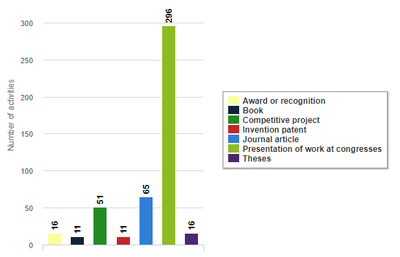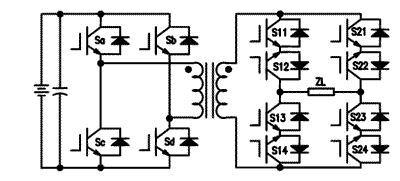Publications
Since its foundation in 1983 until nowadays, GREP has been very productive in terms of scientific publications, having a total of 64 journals papers, 290 conference papers, communications and abstracts, 14 PhD thesis dissertations, 11 books, 10 patents, and 16 awards and recognitions, as shown in the figure below.

- List of the journal papers published since 2012.
- List of the conference papers published since 2012.
- List of the PhD thesis dissertations published since 2004.
- List of the Final Degree Thesis directed since 2008.
GREP's members Journal Papers with most citations from the past 15 years (according to Google Scholar)
Topologies of single-phase inverters for small distributed power generators: an overview
Authors: Yaosuo Xue ; Liuchen Chang ; Sren Baekhj Kjaer ; Bordonau, J. ; Shimizu, T.
Year: 2004
Citations: 768
Abstract:
This paper presents an overview of single-phase inverters developed for small distributed power generators. The functions of inverters in distributed power generation (DG) systems include dc-ac conversion, output power quality assurance, various protection mechanisms, and system controls. Unique requirements for small distributed power generation systems include low cost, high efficiency and tolerance for an extremely wide range of input voltage variations. These requirements have driven the inverter development toward simpler topologies and structures, lower component counts, and tighter modular design. Both single-stage and multiple-stage inverters have been developed for power conversion in DG systems. Single-stage inverters offer simple structure and low cost, but suffer from a limited range of input voltage variations and are often characterized by compromised system performance. On the other hand, multiple-stage inverters accept a wide range of input voltage variations, but suffer from high cost, complicated structure and low efficiency. Various circuit topologies are presented, compared, and evaluated against the requirements of power decoupling and dual-grounding, the capabilities for grid-connected or/and stand-alone operations, and specific DG applications in this paper, along with the identification of recent development trends of single-phase inverters for distributed power generators.

The nearest three virtual space vector PWM - a modulation for the comprehensive neutral-point balancing in the three-level NPC inverter
Authors: Busquets-Monge, S. ; Bordonau, J. ; Boroyevich, D. ; Somavilla, S.
Year: 2004
Citations: 332
Abstract:
This letter presents a new modulation approach for the complete control of the neutral-point voltage in the three-level three-phase neutral-point-clamped voltage source inverter. The new modulation approach, based on the virtual space vector concept, guarantees the balancing of the neutral-point voltage for any load (linear or nonlinear) over the full range of converter output voltage and for all load power factors, the only requirement being that the addition of the output three-phase currents equals zero. The implementation of the proposed modulation is simple according to the phase duty-ratio expressions presented. These expressions are only dependent on the modulation index and reference vector angle. The performance of this modulation approach and its benefits over other previously proposed solutions are verified experimentally.

Interfacing Renewable Energy Sources to the Utility Grid Using a Three-Level Inverter
Authors: Alepuz, S. ; Busquets-Monge, S. ; Bordonau, J. ; Gago, J. ; Gonzalez, D. ; Balcells, J.
Year: 2006
Citations: 326
Abstract:
This paper presents a novel approach for the connection of renewable energy sources to the utility grid. Due to the increasing power capability of the available generation systems, a three-level three-phase neutral-point-clamped voltage-source inverter is selected as the heart of the interfacing system. A multivariable control law is used for the regulator because of the intrinsic multivariable structure of the system. A current source (playing the role of a generic renewable energy source) is connected to the grid using a three-level inverter in order to verify the good performance of the proposed approach. Large- and small-signal d-q state-space averaged models of the system are obtained and used to calculate the multivariable controller based on the linear quadratic regulator technique. This controller simultaneously regulates the dc-link voltage (to operate at the maximum power point of the renewable energy source), the mains power factor (the power is delivered to the grid at unity power factor), and the dc-link neutral-point voltage balance. With the model and regulator presented, a specific switching strategy to control the dc-link neutral-point voltage is not required. The proposed controller can be used for any application, since its nature makes possible the control of any system variable. The good performance of the presented interfacing solution in both steady-state and transient operation is verified through simulation and experimentation using a 1-kW neutral-point-clamped voltage-source-inverter prototype, where a PC-embedded digital signal processor board is used for the controller implementation

Control strategies based on symmetrical components for grid-connected converters under voltage dips
Authors: Alepuz, S.; Busquets-Monge, S.; Bordonau, J.; Martinez-Velasco, J.A.; Silva, C.A.; Pontt, J.; Rodriguez, J.
Year: 2009
Citations: 254
Abstract:
Low-voltage ride-through (LVRT) requirements demand wind-power plants to remain connected to the network in presence of grid-voltage dips. Most dips present positive-, negative-, and zero-sequence components. Hence, regulators based on symmetrical components are well suited to control grid-connected converters. A neutral-point-clamped topology has been considered as an active front end of a distributed power-generation system, following the trend of increasing power and voltage levels in wind-power systems. Three different current controllers based on symmetrical components and linear quadratic regulator have been considered. The performance of each controller is evaluated on LVRT requirement fulfillment, grid-current balancing, maximum grid-current value control, and oscillating power flow. Simulation and experimental results show that all three controllers meet LVRT requirements, although different system performance is found for each control approach. Therefore, controller selection depends on the system constraints and the type of preferred performance features.
Multilevel Diode-Clamped Converter for Photovoltaic Generators With Independent Voltage Control of Each Solar Array
Authors: Busquets-Monge, S. ; Rocabert, J. ; Rodriguez, P. ; Alepuz, S. ; Bordonau, J.
Year: 2008
Citations: 242
Abstract:
In photovoltaic (PV) power systems where a set of series-connected PV arrays (PVAs) is connected to a conventional two-level inverter, the occurrence of partial shades and/or the mismatching of PVAs leads to a reduction of the power generated from its potential maximum. To overcome these problems, the connection of the PVAs to a multilevel diode-clamped converter is considered in this paper. A control and pulsewidth-modulation scheme is proposed, capable of independently controlling the operating voltage of each PVA. Compared to a conventional two-level inverter system, the proposed system configuration allows one to extract maximum power, to reduce the devices voltage rating (with the subsequent benefits in device-performance characteristics), to reduce the output-voltage distortion, and to increase the system efficiency. Simulation and experimental tests have been conducted with three PVAs connected to a four-level three-phase diode-clamped converter to verify the good performance of the proposed system configuration and control strategy.

Share: